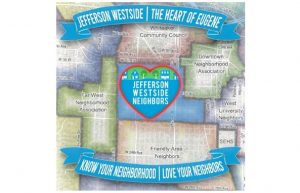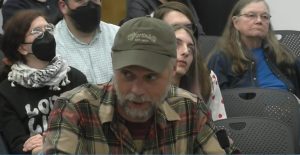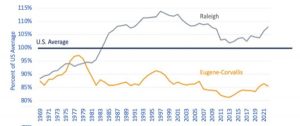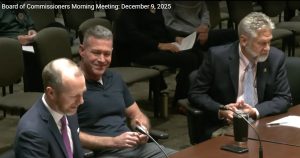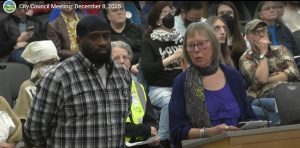State bumps Eugene housing targets 70% to 1,600 units each year
12 min read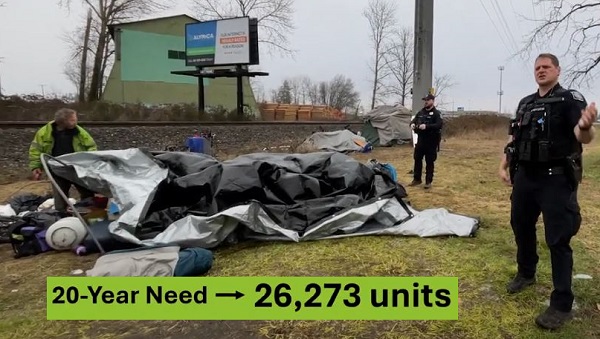
Presenter: Fifty-two years after passage of Oregon’s vaunted land use planning law SB 100, the state has acknowledged cities’ planning failures, and the state will now set the targets itself. At the Eugene Planning Commission Feb. 11, Senior Planner Leah Rausch:
Leah Rausch (Eugene, senior planner): At the state level, the rules guiding housing planning are being completely rewritten. So the Oregon Housing Needs Analysis (OHNA) is really a new paradigm and shift for housing planning across the state.
[00:00:29] Our need is based on a complex methodology that determines the need for the entire state, which is then allocated to each region and then to each city. The new approach considers first our future need, which includes population growth, which is what we’ve planned for in the past. But the OHNA newly considers changes in household formation and planning for units lost to second and vacation homes.
[00:00:54] The OHNA also considers our current unmet need, accounting for decades of underproduction, as well as permanent housing for people experiencing homelessness.
[00:01:05] Presenter: The state released its targets for local housing needs on Jan. 1. Leah Rausch:
[00:01:11] Leah Rausch (Eugene, senior planner): Eugene will need roughly 26,000 new dwelling units over the next 20 years. To put that into perspective, we have about 90,000 dwelling units in Eugene today. That means we are planning to increase our housing stock by roughly 30% over the next 20 years.
[00:01:29] So that’s a big number, but how does it compare to actual housing development on the ground? To meet our more comprehensive housing need, Eugene will need to produce 70% more units annually for the next 10 years, as compared to the last 10 years.
[00:01:47] Using data from our growth monitoring program, we know that Eugene saw an average of about 960 units per year over the last decade. Of those, about 100 were subsidized affordable housing each year.
[00:02:02] To meet our new housing need under the OHNA, Eugene should see closer to 1,600 units per year over the next decade, including about 700 each year that are affordable to households with the lowest incomes.
[00:02:17] Presenter: One planning commissioner wondered how the city will meet its affordable housing goals. Some targets are based on the area median income, or AMI. Ken Beeson:
[00:02:27] Ken Beeson (Eugene Planning Commission): There’s clearly a lot of hous—27,000 units in the next 20 years is a lot. And close to 60% of that needs to be affordable.
[00:02:39] Affordable housing, particularly as it gets down in the lower end of the AMI, means sometimes pretty substantial amounts of money and financing need to be found to make that happen. At the end of the day there needs to be quite a lot of money. Not to understate it, but there’s not a lot going on right now either at the local level, state level, or national level to make one think that kind of money might be forthcoming.
[00:03:11] And I’m assuming the 20-year period started last month, started in January of 2025, right? So we’re sort of on the clock right now at 1,600 units a year.
[00:03:25] Leah Rausch (Eugene, senior planner): It’s a good observation, Commissioner Beeson. It well articulates the kind of pickle we are in and it’s going to take a long time to dig out of our current deficit of housing.
[00:03:37] Presenter: Planning Commissioner Dan Isaacson:
[00:03:40] Dan Isaacson (Eugene Planning Commission): To kind of echo what Commissioner Beeson was saying, I guess I just have a really basic math question. Based on the available space that Eugene has, how many units are available, if you had a magic wand to build right now?… You know, we’re using this much space for housing developments where I need x number of them, x and y times each other gives you this much space, this is how much space we have, (equals what) your possibilities, your limits are.
[00:04:06] Presenter: The big numbers suggest that Eugene will be expanding its urban growth boundary. Leah Rausch.
[00:04:12] Leah Rausch (Eugene, senior planner): I don’t know off the top—we do have the buildable lands inventory. So that is the closest we have to kind of knowing exactly how much could be built. That will be updated as a part of this process, so we’ll have a better sense of, on our current land supply, what can we realistically assume in our current urban growth boundary. And that is why we expect we’ll need to do a UGB expansion. These numbers are too big to accommodate through efficiencies alone.
[00:04:41] Presenter: Dan Isaacson:
[00:04:42] Dan Isaacson (Eugene Planning Commission): I don’t think that it’s bad to shy away from the large number or hide that or pretend that it doesn’t exist. It exists, right? The analysis—the data is what the data is, you know, and I don’t think we adjust the data to make ourselves feel better or to create a goal that we can achieve to pat ourselves on the back to not ultimately help the problem we’re trying to solve, you know?
[00:05:00] But on that other end, I think that it’s important that the public realizes the size of the mountain we’re trying to climb here, and recognizes that it’s an all-hands-on-deck approach that they need, you know, business, they need, you know, the city, it’s going to be philanthropic, private development, all those things that are working in tandem…
[00:05:21] I mean, just get an idea of the size of what we’re talking about here. To hit that number for just the zero to 80% AMI, we would need to build 211 Peace Village-size developments over 20 years. That’s almost 11 per year. And it took two years, I think, to build, right? So that’s a big nut to be able to go after, right?
[00:05:50] So with the federal priorities shifting, policy is definitely moving around. How much of the analysis that we’re looking at is relying on assumptions based on federal funding that existed prior to three and a half months ago?
[00:06:07] Presenter: That is, before the November election of President Trump and Republican majorities in the House and Senate. Leah Rausch:
[00:06:15] Leah Rausch (Eugene, senior planner): Yeah, it’s a great question. I would say that the OHNA doesn’t consider funding, kind of point blank, like, it is attempting to be a more comprehensive picture of what our need is. It’s not saying that there’s realistic resources to actually build that much housing in the next few years.
[00:06:38] So I think the OHNA sets a high bar and most cities are not going to meet that bar in the next couple of years, right? But it really is trying to drive home the point that we are severely underproducing housing to meet our needs and that we’re going to have to figure out collectively—local, state and federal levels—how to meet that need through traditional funding means, but also through, you know, creative strategies to look at how we can provide affordability differently, to ensure we have enough land, to continue reducing regulatory barriers. But the OHNA doesn’t assume a certain level of investment from the state or the federal level.
[00:07:22] Presenter: Commissioner Jason Lear asked about existing covenants, conditions, and restrictions, called CC&Rs, that prohibit greater housing density.
[00:07:31] Jason Lear (Eugene Planning Commission, chair): I’m curious if there is anything new on the state level that might address the conflict between preexisting CC&Rs and middle housing or other forms of more dense development?
[00:07:46] Presenter: Planning’s Alissa Hansen:
[00:07:48] Alissa Hansen (Eugene, planning): There is a House bill that contains language that would, I guess, make those go away. We’re not sure it’s actually legal or will move forward, but there is a House bill that does talk about doing just that.
[00:08:04] Presenter: As it did with its middle housing initiative, the city said it will continue to handpick specific groups to provide feedback on its work. Principal Planner Terri Harding:
[00:08:15] Terri Harding: Our community engagement plan, which you all approved last February, includes a variety of integrated tactics and activities, both general, broad, and focused to specific communities. Many of these are already underway with more coming up over the next two years.
[00:08:33] The things I’d like to highlight for you that are coming up next are more engagement opportunities and the equity advisory panel which is launching in March and that will build on what we’ve learned from past equity panels that the city has run and we’re excited to have community collaborators running that for us from working with a group of BIPOC community members.
[00:08:55] Presenter: Even as the state takes charge of housing production targets, the city acknowledges it will probably not meet them.
[00:09:03] Homelessness is a housing problem. The city’s past planning failures made Eugene worst in the nation, with the highest per capita rate of homelessness. While city managers and planners are still comfortably employed, the city is directing Eugene Police to punish the victims of the city’s own failed policies.
[00:09:23] During the same week as the February Planning Commission meeting, in sub-freezing temperatures and an approaching ice storm, videographer Tim Lewis provided some early feedback for the city planners.
[00:09:36] Tim recorded Eugene Police sweeping homeless encampments, forcing our most vulnerable neighbors out of survival shelter and into the cold. Here he speaks with James, then Theo.
[00:09:47] James: Fifth move in about five or six months now, and it’s just becoming exhausting, the moving part of it, and not knowing where we’re going.
[00:09:55] Tim: We also heard that you guys weren’t supposed to be moved in difficult weather when it’s really cold, but it seems to be happening anyway, huh?
[00:10:00] James: Yeah, they’re not really supposed to be doing that because they, and at some points they take everybody’s, all their stuff, so the guys are left outside without anywhere to sleep, no blankets, no bedding, nothing, so that could kill people.
[00:10:11] Theo: Every time I get a bunch of stuff, they have it all taken away. You know, if they take stuff away that causes you to die, isn’t that an attempted murder charge? (Yeah.) So that’s what happens when they take all your blankets… You know what they did yesterday? They arrested me, took me to jail, and released me, just long enough for them to take the cart with everything I owned in it, that kept me alive. My food!
[00:10:31] Presenter: Tim recorded a sweep by Eugene Police.
[00:10:35] Eugene Police Officer #1: My body camera’s going. Nobody’s free to leave. Everybody’s being detained. Can everybody just step over here and chat with us?
[00:10:40] Eugene Police Officer #2: Can we get everybody over here so we don’t have to repeat ourselves and we can just talk to everybody? Well, we’re going to talk to you guys and identify you and you all may or may not get citations.
[00:10:55] Tim: So this is pretty much what it’s like all the time, James? When you get swept, like this?
[00:11:01] James: Yeah. (Yeah.) I usually leave before they show up. I just, if they ask us to leave, I usually leave. That’s why I’m leaving right now, you know?
[00:11:09] Presenter: Tim caught up with James a few miles towards town.
[00:11:12] James: They didn’t make my bad decisions for me. I made my bad decisions that led me to where I am now.
[00:11:17] Tim: Well, you can’t keep blaming yourself either.
[00:11:19] James: I’m not just blaming myself. There’s things that are wrong out here… I’ve made a lot of bad decisions, but there’s something wrong going on here.
UPDATE Feb. 21, 2025: A Eugene Police Department spokesperson responds:
“The use of the photo and the caption is misleading. This photo was taken at Portland Western RR property just south of Beltline, an area that has a high number of complaints and the photo is of private property the owners worked with EPD to keep clean. There is a distinction between ongoing work with property owners and work done or not done on public property, right of way, parks, etc. These details are important. The officers pictured are doing the jobs the community pays them to do, and in this case it was a request from the private property owner. This characterization of them is unfair and inaccurate.
“Housing Support Officers (HSOs) in general focus on right of way problems, camping, supporting the cleanup of camps by Public Works crews, and trespass to include railroad property (which many people forget is private property). Within the camping ordinance, EC 4.815, there are specific incidents that have been deemed ‘immediate removal camps’ due to the hazards and safety issues they present to the camper and public in general. By ordinance, there must be some sort of structure as well to fall under 4.815 enforcement. This can be a tent, a tarp structure, or similar things. The immediate removal incidents include being 5’ or less from a roadway, being within 1000’ of a school or educational facility, waterway hazards, and blocking a sidewalk or path and not allowing for the allotted amount of room for someone to pass per ADA laws.
“4.815 follows ADA requirements and keeping the camper and vehicle traffic safe are the key points. During ice events, if a vehicle hits ice and goes off the road, a tent within that 5’ area is most likely to be a casualty, and when its already snow and ice out, limiting the walkway for a person with disabilities has a higher safety concern than when conditions are not slippery.
“When cold weather protocols are in place, the HSOs have been directed by their supervisor to limit what they would normally focus on to criminal trespass, and the immediate removal situations. They also still have discretion to deal with a camp that is an extreme hazard to the point that they articulate disorderly conduct.
“We looked at the HSOs stats for the week when it was snowing and freezing weather (February 10-February 13). There were no citations or arrests made for general camping. All the citations involved criminal trespassing or hazards.”
Whole Community News responds to EPD:
The article attempts to point out that if homelessness is indeed a housing problem, there is a direct link between city planning policies and the nation’s worst rate of homelessness. The picture attempts to illustrate that connection.
We assert that the wording of the headline, caption, and article accurately reflect that EPD is following policy direction from the city leaders (council, city manager, and other directors): “The city directed Eugene Police…” We’ve reported on this in great detail over the past five years:
- The city eliminated its citizen involvement committee ~20 years ago, shifting engagement to the Planning Commission
- Planning actions ever since that loss of the citizen involvement committee have preserved the existing urban growth boundary at the cost of building needed housing stock
- The city declined to catalog existing covenants, conditions, and restrictions (CC&Rs), which would indicate where additional building is not allowed
- City planners failed to comply with state Planning Goals 1, 10, and 11
- Even as the homeless crisis grew, city planners continued to report to elected officials that they had met or exceeded their housing production goals
- Eugene has the worst per-capita homelessness in the nation
- The governor declared and extended a homelessness emergency
- The city attorney, when asked point blank, declined to identify places where homeless persons can safely and legally camp
- The existing emergency shelter system can only serve a fraction of the ~3,600 homeless in the Eugene area (5,120 in Lane County, 70% here, according to the Lane County homelessness dashboard for January)
- Sweeps occur despite the Shelter Finder software indicating that there are no eligible slots
- Although a Human Rights Commission study showed it would be cheaper to provide shelter, the city has chosen to criminalize homelessness
- Criminalization undermines the city and county’s efforts to provide human services and protect public health. There are currently increased reports of shigella in the county
- Taxpayers are paying twice – for city and county efforts to move unhoused into housing, and for EPD / Parks Police / ambassadors to undo those efforts by criminalizing the unhoused.
We admire and respect all of those who serve in the Eugene Police Department and who put their lives on the line every day in service to our community. In our role as solution journalists, we hope to clearly identify city policies that are ineffective and counterproductive, in an effort to draw attention to those failed policies and change them.
